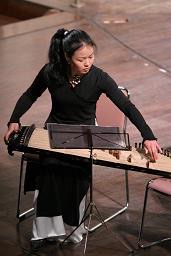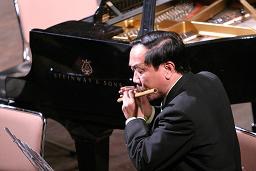Performances
Premiere: Hanoi Opera House, Nguyen Thanh Thuy, dan tranh, Le Pho, shao, January 2, 2005.
Program Note
This work was commissioned by Phong Nguyen.
In August of 2001, I heard a concert of Vietnamese music performed by Phong and his ensemble at the Cleveland Museum of Art. I had heard him perform only once previously, in a private home in Akron on the monochord. I was fascinated by the expressive quality of that performance. Phong is a very friendly and agreeable person, and when I expressed admiration for his music and my wish to learn more about it, he was so accommodating—going so far as to invite me to dinner at his house and give me a demonstration on some instruments—he even lent me one of his own instruments so I that could experiment with it!
I wanted very much to try to write a piece for Phong, but it took me many months to overcome the various obstacles that seemed to stand in the way. For one thing, the Vietnamese musical tradition is long, complex and serious. Even after I had read up on the subject and listened to a number of recordings, questions remained about how I should approach the writing. For whom would I write and with what purpose in mind? As a foreigner, I could not possibly attain a
ny sort of sophisticated understanding of the art of Vietnamese music. And yet—I was in possession of Phong’s instrument and felt I could not return it without giving him a gift of at least one piece of music!
Finally, I decided I would try to write a piece that expressed my respect and admiration for the tradition, without attempting to show any cleverness of my own—to express myself naturally as I would in writing any other piece of music. The problem of how to notate such music then became central—especially how to notate the many uniquely expressive ornaments I had heard, as well as the issue of how to preserve the spontaneity and improvisatory freedom in performance that is part of the Vietnamese musical tradition. There seemed to be no standard way of notating Vietnamese music, so I turned to a combination of traditional and modern Western “proportional notation” as a way of solving this dilemma.
If traditional performers are not familiar with this type of notation, perhaps this could be an opportunity to learn something new. I realized that the piece could serve as a kind of educational vehicle for audiences and performers alike—in some small way to bring people who have become closer by virtue of history and circumstance, even closer through cultural sharing.
The title of the piece comes from the written characters for sao, the flute, and dan tranh, the zither. Sao can mean “small” and dan can mean “quarrel.” The piece attempts to depict a little quarrel between the two instruments, and its resolution through sharing and compromise.


